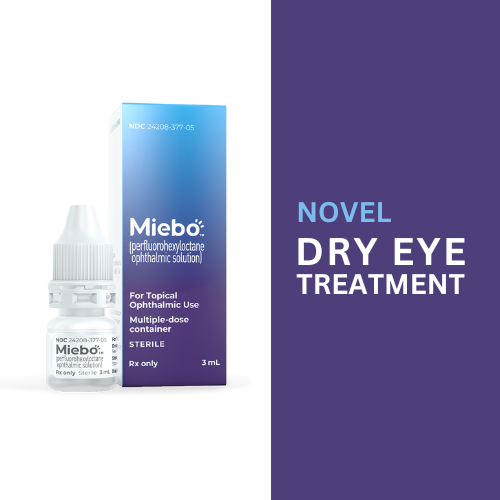New Dry Eye Treatment | MIEBO™


In May, Bausch + Lomb announced that the FDA approved MIEBO™ (perfluorohexyloctane ophthalmic solution; formerly known as NOV03) for the treatment of the signs and symptoms of dry eye disease (DED). MIEBO™ is administered as a single drop into each eye, four times a day, and is designed to reduce tear evaporation at the ocular surface. The only ingredient in MIEBO™ is perfluorohexyloctane.
Perfluorohexyloctane (PFHO) is a semifluorinated alkane containing 6 perfluorinated carbon atoms and 8 hydrogenated carbon atoms. PFHO has low surface tension and strong spreading characteristics.
Perfluorohexyloctane eye drops for dry eye treatment have been used in Europe to treat dry eye disease since 2021.
Perfluorohexyloctane has been used in ophthalmology as a long-term vitreous substitute. It also has a density higher than water and very low surface and interface tensions. In addition, as it is a non-aqueous liquid, microbial growth is not possible and therefore, it does not need any preservative.
Microbial growth typically requires the presence of water or other suitable conditions for bacteria or other microorganisms to thrive. Since PFHO lacks water, it does not provide an environment conducive to microbial growth.
In addition, PHFO is chemically inert, which means that it does not react with other substances. This makes it difficult for microbes to attach to PHFO and form a biofilm. Biofilms are a type of microbial community that can grow on surfaces and cause infections.
How does MIEBO™ to treat dry eyes?
Surface tension refers to the cohesive forces that exist between molecules at the surface of a liquid. Liquids with lower surface tension have a greater ability to spread out over a surface. In the case of PFHO, its low surface tension allows it to quickly and easily cover the surface of the eye when applied as eye drops.
When PFHO is instilled into the eye, it forms a thin layer that spreads across the surface of the tear film. The tear film is a complex structure composed of several layers, including an outer lipid (lipophilic) layer, an aqueous layer, and an inner mucus layer. The lipid layer plays a crucial role in preventing excessive evaporation of tears from the ocular surface.
PFHO interacts specifically with the lipophilic part of the tear film, aligning its molecules with the lipids present in the tear film. This alignment allows PFHO to form a stable layer at the interface between the tear film and the air, effectively reducing evaporation. By preventing excessive evaporation, PFHO helps maintain the stability and integrity of the tear film, providing relief to individuals with dry eyes.
The ability of PFHO to spread easily over the ocular surface enables the formation of small drop sizes. Smaller drop sizes provide more efficient coverage, as they can disperse evenly across the eye and minimize waste. This spreading property also contributes to the formation of a continuous and uniform layer of PFHO, ensuring optimal protection against tear evaporation.
In summary, the strong spreading properties of PFHO, facilitated by its low surface tension, allows it to quickly cover the ocular surface in the form of small droplets. It interacts with the lipophilic part of the tear film, forming a layer at the film-air interface that helps prevent tear evaporation and maintain the stability of the tear film, thus providing relief for dry eyes.
Gregory Scimeca, M.D.
Ophthalmologist and Medical Director
The Eye Professionals
Our Locations
